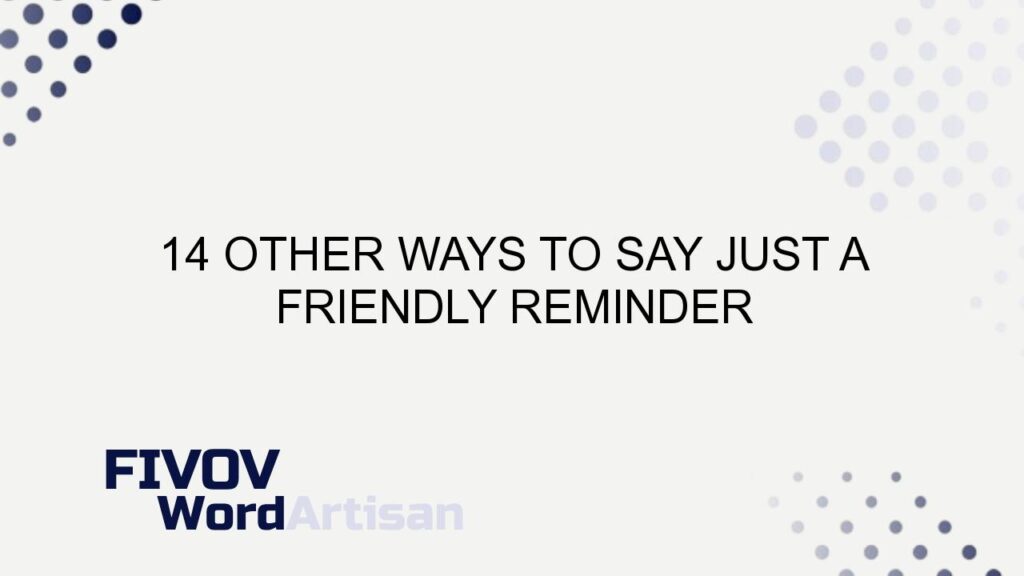Are you attempting to determine if something is feasible but find yourself needing to inquire first? Maybe you’re concerned that the phrase “just a friendly reminder” might not be the most professional way to ascertain if an action can be undertaken.
MY LATEST VIDEOS
Well, you’ve come to the right place to find out more. This article will show you how to professionally say “just a friendly reminder” when you need it.
Other Ways to Say “Just a Friendly Reminder”
When it comes to professional communication, it’s crucial to use language that conveys your message clearly and effectively. As such, it’s important to have alternative ways to express the idea of a friendly reminder. Here are 14 other phrases you can use to convey the same message in a professional manner:
1. Gentle Nudge
2. Polite Prompt
3. Subtle Reminder
4. Courteous Heads-Up
5. Kindly Note
6. Respectful Reminder
7. Tactful Nudge
8. Considerate Prompt
9. Thoughtful Reminder
10. Diplomatic Heads-Up
11. Cordial Note
12. Amiable Reminder
13. Pleasant Nudge
14. Affable Prompt
Using these alternative phrases can help you communicate your message in a professional and courteous manner.
Why it’s Important to Use Professional Language
Professional communication is essential in various aspects of life, whether it’s in the workplace, academic settings, or social interactions. Using professional language conveys respect, consideration, and thoughtfulness, which are all important in maintaining positive relationships and interactions.
When it comes to sending reminders or prompts, using professional language can make the recipient more receptive to the message. It can also help avoid any misinterpretations or misunderstandings that may arise from using language that is too casual or informal.
Tips for Professional Communication
In addition to using alternative phrases for “just a friendly reminder,” here are some tips for maintaining professional communication:
1. Be Clear and Concise: Use language that is clear and to the point, avoiding unnecessary verbosity or ambiguity.
2. Use Proper Salutations: When addressing individuals, especially in written communication, use appropriate salutations such as “Dear,” “Hello,” or “Good morning/afternoon.”
3. Maintain Politeness: Always maintain a polite and respectful tone in your communication, regardless of the nature of the message.
4. Proofread Your Message: Before sending any written communication, be sure to proofread for spelling, grammar, and tone to ensure clarity and professionalism.
5. Consider the Recipient: Tailor your language and tone based on the recipient and the context of the communication. Different situations may require different levels of formality.
By following these tips and using professional language, you can enhance your communication skills and build positive relationships in various settings.
FAQs
What is the Difference Between Professional and Casual Language?
Professional language is characterized by formality, clarity, and respect. It is used in professional settings such as workplaces, academic environments, and formal correspondence. Casual language, on the other hand, is more relaxed and informal, often used in social interactions and friendly communication.
How Can I Practice Using Professional Language?
One way to practice using professional language is to review and analyze your written and verbal communication. Pay attention to the tone, clarity, and formality of your messages and identify areas for improvement. You can also seek feedback from colleagues, mentors, or communication experts to refine your professional language skills.
Conclusion
Effective communication is a cornerstone of successful interactions, and using professional language is a key component of this. By incorporating alternative phrases for “just a friendly reminder” and following the tips for professional communication, you can enhance your ability to convey messages in a professional, respectful, and effective manner. Remember to consider the recipient and the context of the communication when choosing your language, and always aim to foster positive and productive interactions through your professional communication.




